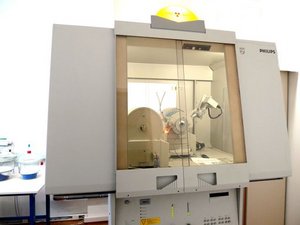Röntgendiffraktometrie

X-ray diffraction represents an essential tool for the analyses of crystal structures, especially of fine-grained sediments like clay minerals. The basic principle of XRD is the diffraction of X-rays on crystal lattice. According to the lattice parameters and chemical composition each mineral reflects characteristic X-radiation. By means of this examination method it is possible to identify and further characterize mineral phases. Both qualitative and quantitative analyses are performed.
Priciple of XRD: The radiation generated by the X-ray tube is fouced by a collimator and directed toward the sample. The radiation is reflected according to the Bragg's Law: n?=2d sin?, which relates the wavelength of electromagnetic radiation to the diffraction angle and the lattice spacing of a mineral structure. The diffracted X-rays are detected, processed and counted by means of a radiation counter and displayed in a diffractogram.
For the radiographical phase analyses a Philips X-pert System with two goniometers is available. The processing and exposition takes places by the software package ADEM V6, Wassermann X-ray analytical equipment.